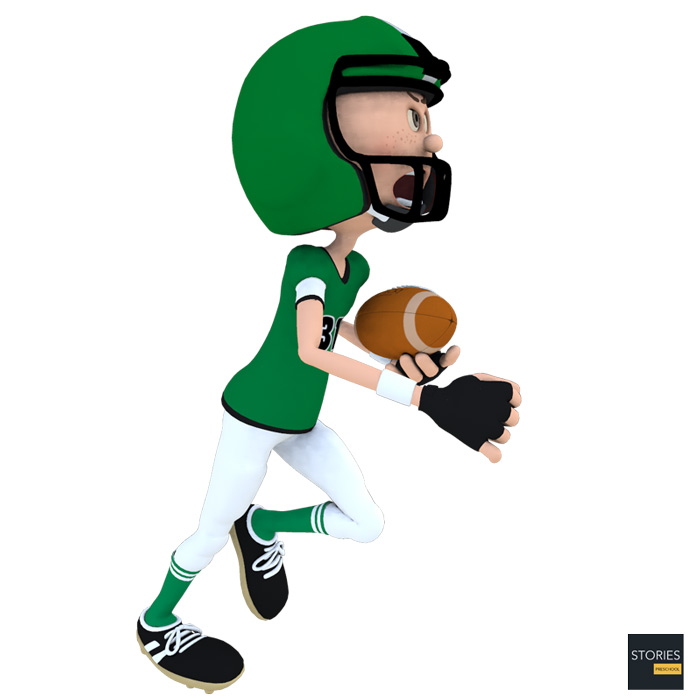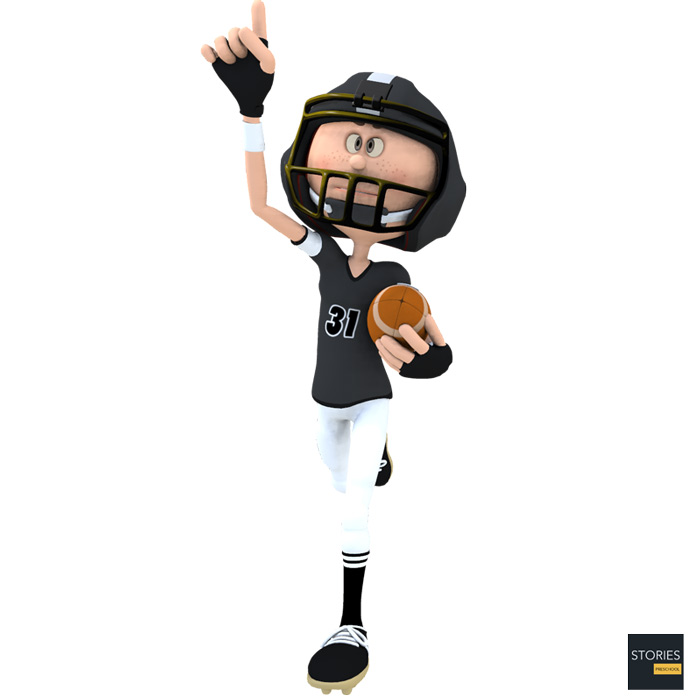American football

Running Back (RB)
A running back (RB) is an American and Canadian football position, a member of the offensive backfield. The primary roles of a running back are to receive handoffs from the quarterback for a rushing play, to catch passes from out of the backfield, and to block. There are usually one or two running backs on the field for a given play, depending on the offensive formation. A running back may be a halfback (in certain contexts also referred to as a tailback) or a fullback.

Halfback/tailback
The halfback (HB) or tailback (TB) position is responsible for carrying the ball on the majority of running plays, and may frequently be used as a receiver on short passing plays.
In the modern game, an effective halfback must have a blend of both quickness and agility as a runner, as well as sure hands and good vision up-field as a receiver. Quarterbacks depend on halfbacks as a safety valve receiver when primary targets downfield are covered or when they are under pressure. Occasionally, halfbacks line up as additional wide receivers.
When not serving either of these functions, the primary responsibility of a halfback is to aid the offensive linemen in blocking, either to protect the quarterback or another player carrying the football. As a trick play, running backs are occasionally used to pass the ball on a halfback option play or halfback pass.
The difference between halfback and tailback is the position of the player in the team's offensive formation. In historical formations, the halfback lined up approximately half-way between the line of scrimmage and the fullback (similarly, quarterbacks lined up a quarter of the distance between the line of scrimmage and the fullback). Because the halfback is usually the team's main ball carrier (while the fullback is primarily a blocker), modern offensive formations have positioned the halfback behind the fullback (at the "tail end" of the formation), to take advantage of the fullback's blocking abilities. As a result, some systems or playbooks will call for a tailback as opposed to a halfback.
The term tailback is often used in Canadian football interchangeably with running back, while the use of the term halfback is often exclusively reserved for the defensive halfback, which refers to the defensive back halfway between the linebackers and the cornerbacks.
Fullback
In most modern college and professional football schemes, fullbacks (FB) carry the ball infrequently, instead using their larger physiques as primary "lead blockers." On most running plays, the fullback leads the halfback, attempting to block potential tacklers before they reach the ball carrier.
When fullbacks are called upon to carry the ball, the situation typically calls for gaining a short amount of yardage, as the fullback can use his bulkiness to avoid being tackled early. Fullbacks are sometimes receivers for passing plays, although most plays call for the fullback to block any defensive players that make it past the offensive line, a skill referred to as "blitz pickup". Fullbacks are technically running backs, but today the term "running back" is usually used in referring to the halfback or tailback. Although modern fullbacks are rarely used as ball carriers, in previous offensive schemes fullbacks would be the designated ball carriers.
In high school football, where player sizes vary greatly, fullbacks are still frequently used as ball carriers. In high school and college offenses, the triple option scheme uses the fullback as a primary ball carrier. The fullback plays a unique role by establishing an inside running threat on every play. College teams such as Georgia Tech and Air Force have employed the triple option scheme.
While in years past the fullback lined up on the field for almost every offensive play, teams often opt to replace the fullback with an additional wide receiver or a tight end in modern football. Fullbacks in the National Football League rarely carry or catch the ball since they are used almost exclusively as blockers. Fullbacks are also still used occasionally as rushers on plays when a short gain is needed for a first-down or touchdown. Jim Brown, Marion Motley, Franco Harris, John Riggins, and Larry Csonka were fullbacks.
Characteristics of a running back
Height and weight
There is a diversity in those who play at the running back position. At one extreme are smaller (5'4"–5'10"), shiftier players. These quick, agile, and elusive running backs are often called "scat backs" because their low center of gravity and maneuverability allow them to dodge tacklers.
At the other extreme are "power backs:" bigger, stronger players who can break through tackles using brute strength and raw power. They are usually slower runners compared to other backs, and typically run straight ahead (or "North-and-South" in football terminology) rather than dodging to the outside edges of the playing field (i.e. running "East-and-West") like shorter, quicker, lighter backs will often do.
Receiving ability
Over the years, NFL running backs have been used more and more as receivers out of the backfield. On passing plays, a running back will often run a "safe route," such as a hook or a flat route, that gives a quarterback a target when all other receivers are covered or when the quarterback feels pressured.
Some teams have a specialist "third down back," who is skilled at catching passes or better at pass blocking and "picking up the blitz," and thus is often put in the game on third down and long. It can also be used to fool the defense by making them think it is being put into the game for a pass play, when the play is actually a run.
Blocking
Running backs are also required to help the offensive line in passing situations, and, in the case of the full back, running plays. Running backs will often block blitzing linebackers or safeties on passing plays when the offensive line is occupied with the defensive linemen. On running plays, the fullback will often attempt to tear a hole in the offensive line for the running back to run through. Effective blocking backs are usually key components for a running back's success. On passing plays, a running back will stay back to help block and pick up the blitz.

Goal line backs
Many teams also have a running back designated as a "goal line back" or "short yardage specialist". This running back comes into the game in short yardage situations when the offense needs only a little bit of yardage to get a first down or a touchdown. They also come into the game when the offense nears the goal line. Normally when an offense gets inside the 5-yard line it sends in its goal line formation, which usually includes eight blockers, a quarterback, a running back, and a fullback. The closer it is to the goal line the more likely it is to use this formation. If a certain running back is used often near the goal line he may be called the "goal line back." Short yardage and goal line backs often are power backs that are not prone to fumbling. Their job is to get the first down or touchdown by muscling through or pushing a large mass of defenders to push their way to the designated area.
Kick and punt returners
Running backs are sometimes called upon to return punts and kickoffs, a role usually filled by wide receivers and defensive backs, such as cornerbacks, who are generally the fastest players on the team. A running back, Brian Mitchell, currently holds the NFL records for career kickoff return yards (14,014 yards) and career punt return yards (4,999).
SPORTS



American Football
Game play in American football consists of a series of downs, individual plays of short duration, outside of which the ball is dead or not in play. These can be plays from scrimmage – passes, runs, punts, or field goal attempts (from either a place kick or a drop kick) – or free kicks such as kickoffs and fair catch kicks. Substitutions can be made between downs, which allows for a great deal of specialization as coaches choose the players best suited for each particular situation. During a play, each team should have no more than 11 players on the field, and each of them has specific tasks assigned for that specific play.
Rules and gameplay
- Scoring
- Maneuvers
- Strategy
- Play types
- Penalties
- Turnovers
- Downs
- Teams and positions
- Field
- Equipment
- Duration and time stoppages
- Advancing the ball and downs
- Kicking
- Officials and fouls
Positions
Offensive (Interior) line
Backs and receivers
Defensive line
Linebackers
Defensive backs
Special teams
- Kicker (K)
- Holder (H)
- Long snapper (LS)
- Punter (P)
- Kickoff specialist (KOS)
- Kick returner (KR) and Punt returner (PR)
- Upback
- Gunner
- Jammer


RESOURCES
This article uses material from the Wikipedia articles "American football", "American football positions" and "Running back", which is released under the Creative Commons Attribution-Share-Alike License 3.0.
© Stories Preschool. All Rights Reserved.





